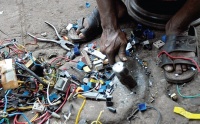India – In recent years, India has witnessed rising e-scrap exports because the country still lacks a ‘full-fledged’ facility capable of extracting precious metals, as a consequence of which roughly 200 tonnes of e-scrap are annually shipped off to Singapore, Belgium and Japan.
A large proportion (18 000 tonnes) of India’s e-scrap comes from Bangalore, the country’s third most populous city and widely known as the ‘Silicon Valley of India’ because it is its leading IT exporter. A recent study ranked Bangalore first on the list of India’s leading e-scrap producers, with Mumbai in second place on approximately 10 000 tonnes of e-scrap per year.
But there is a way out of this e-scrap maze, claims S Nanda Kumar, chief environmental officer at the Karnataka State Pollution Control Board. But while India’s central government implemented the E-waste Manaagement and Handling Rules in 2012, a ‘huge investment’ is required to establish a unit to extract high-value metals from electronic devices and equipment.
Partially recovered
Meanwhile, the country’s many recyclers are facing a financial crunch. ‘Shipping the material abroad costs a lot of money; around 25% of the value of extracted metals goes to the foreign companies and India gets the rest,’ claims P. Parthasarathy, managing director of E-Parisara Pvt. At present, his Bangalore-based company is the ‘first government-authorised business’ that can, if only partially, recover precious metals from e-scrap. ‘We can extract them from visible parts like motherboards and mobile phones,’ Parthasarathy adds.
However, India does not have a sophisticated smelting plant available to extract invisible precious metals from the multitude of discarded electronics. Instead of processing the material within its borders, the recycler says it is sent en masse to Belgium, Japan and also Singapore. He echoes Kumar’s contention that a major smelting capacity investment is required.
On a positive note, Parthasarathy reveals: ‘We are in the process of establishing a full-fledged e-waste recycling site with the help of the central government under a public-private partnership model. We’ll complete the project within three to four years. The first phase is ready.’
For more information, visit: www.ewasteindia.com
Source: ‘The Times of India’
Don't hesitate to contact us to share your input and ideas. Subscribe to the magazine or (free) newsletter.



